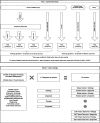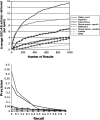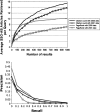Using citation data to improve retrieval from MEDLINE
- PMID: 16221938
- PMCID: PMC1380202
- DOI: 10.1197/jamia.M1909
Using citation data to improve retrieval from MEDLINE
Abstract
To determine whether algorithms developed for the World Wide Web can be applied to the biomedical literature in order to identify articles that are important as well as relevant. DESIGN AND MEASUREMENTS A direct comparison of eight algorithms: simple PubMed queries, clinical queries (sensitive and specific versions), vector cosine comparison, citation count, journal impact factor, PageRank, and machine learning based on polynomial support vector machines. The objective was to prioritize important articles, defined as being included in a pre-existing bibliography of important literature in surgical oncology. RESULTS Citation-based algorithms were more effective than noncitation-based algorithms at identifying important articles. The most effective strategies were simple citation count and PageRank, which on average identified over six important articles in the first 100 results compared to 0.85 for the best noncitation-based algorithm (p < 0.001). The authors saw similar differences between citation-based and noncitation-based algorithms at 10, 20, 50, 200, 500, and 1,000 results (p < 0.001). Citation lag affects performance of PageRank more than simple citation count. However, in spite of citation lag, citation-based algorithms remain more effective than noncitation-based algorithms. CONCLUSION Algorithms that have proved successful on the World Wide Web can be applied to biomedical information retrieval. Citation-based algorithms can help identify important articles within large sets of relevant results. Further studies are needed to determine whether citation-based algorithms can effectively meet actual user information needs.
Figures
Similar articles
-
Automatic identification of high impact articles in PubMed to support clinical decision making.J Biomed Inform. 2017 Sep;73:95-103. doi: 10.1016/j.jbi.2017.07.015. Epub 2017 Jul 26. J Biomed Inform. 2017. PMID: 28756159 Free PMC article.
-
Using incomplete citation data for MEDLINE results ranking.AMIA Annu Symp Proc. 2005;2005:316-20. AMIA Annu Symp Proc. 2005. PMID: 16779053 Free PMC article.
-
G-Bean: an ontology-graph based web tool for biomedical literature retrieval.BMC Bioinformatics. 2014;15 Suppl 12(Suppl 12):S1. doi: 10.1186/1471-2105-15-S12-S1. Epub 2014 Nov 6. BMC Bioinformatics. 2014. PMID: 25474588 Free PMC article.
-
Promise and pitfalls of extending Google's PageRank algorithm to citation networks.J Neurosci. 2008 Oct 29;28(44):11103-5. doi: 10.1523/JNEUROSCI.0002-08.2008. J Neurosci. 2008. PMID: 18971452 Free PMC article. Review. No abstract available.
-
Literature search using PubMed: an essential tool for practicing evidence- based medicine.J Assoc Physicians India. 2006 Apr;54:303-8. J Assoc Physicians India. 2006. PMID: 16944614 Review.
Cited by
-
A comparison of citation metrics to machine learning filters for the identification of high quality MEDLINE documents.J Am Med Inform Assoc. 2006 Jul-Aug;13(4):446-55. doi: 10.1197/jamia.M2031. Epub 2006 Apr 18. J Am Med Inform Assoc. 2006. PMID: 16622165 Free PMC article.
-
Accessing biomedical literature in the current information landscape.Methods Mol Biol. 2014;1159:11-31. doi: 10.1007/978-1-4939-0709-0_2. Methods Mol Biol. 2014. PMID: 24788259 Free PMC article. Review.
-
Automatic identification of high impact articles in PubMed to support clinical decision making.J Biomed Inform. 2017 Sep;73:95-103. doi: 10.1016/j.jbi.2017.07.015. Epub 2017 Jul 26. J Biomed Inform. 2017. PMID: 28756159 Free PMC article.
-
Top Skin-of-Color Publications in Dermatology.JMIR Dermatol. 2022 Jun 6;5(2):e37256. doi: 10.2196/37256. JMIR Dermatol. 2022. PMID: 37632864 Free PMC article. No abstract available.
-
Predicting biomedical document access as a function of past use.J Am Med Inform Assoc. 2012 May-Jun;19(3):473-8. doi: 10.1136/amiajnl-2011-000325. Epub 2011 Sep 13. J Am Med Inform Assoc. 2012. PMID: 21917645 Free PMC article.
References
-
- Zipser J. MEDLINE to PubMed and beyond. Available from: http://www.nlm.nih.gov/bsd/historypresentation.html/. Accessed 2005 Mar 29.
-
- PubMed. Available from: http://www.ncbi.nlm.nih.gov/pubmed/. Accessed 2005 Mar 29.
-
- NLM. MEDLINE Fact Sheet. WWW. September 18, 2002. Available from: http://www.nlm.nih.gov/pubs/factsheets/medline.html/. Accessed 2003 Apr 30.
-
- Wilson SR, Starr-Schneidkraut N, Cooper MD. Use of the critical incident technique to evaluate the impact of MEDLINE. Final Report. Palo Alto, CA, 1989.
-
- Marshall JG. The impact of information provided by the hospital libraries in the Rochester area: Rochester Regional Library Council, 1991.
Publication types
MeSH terms
Grants and funding
LinkOut - more resources
Full Text Sources
Other Literature Sources




